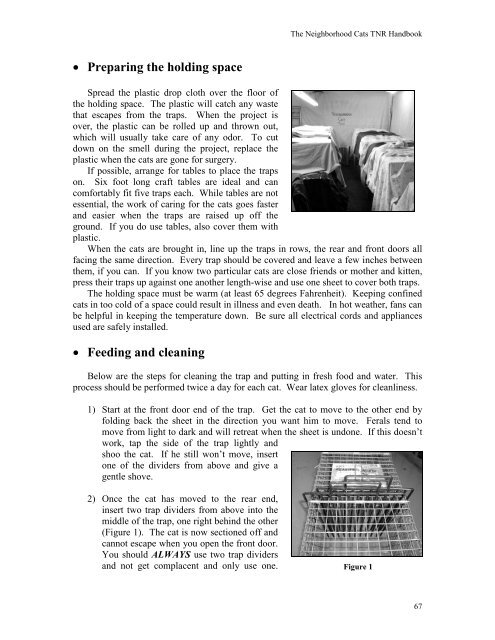Create successful ePaper yourself
Turn your PDF publications into a flip-book with our unique Google optimized e-Paper software.
• Preparing the holding space<br />
The <strong>Neighborhood</strong> <strong>Cats</strong> <strong>TNR</strong> <strong>Handbook</strong><br />
Spread the plastic drop cloth over the floor of<br />
the holding space. The plastic will catch any waste<br />
that escapes from the traps. When the project is<br />
over, the plastic can be rolled up and thrown out,<br />
which will usually take care of any odor. To cut<br />
down on the smell during the project, replace the<br />
plastic when the cats are gone for surgery.<br />
If possible, arrange for tables to place the traps<br />
on. Six foot long craft tables are ideal and can<br />
comfortably fit five traps each. While tables are not<br />
essential, the work of caring for the cats goes faster<br />
and easier when the traps are raised up off the<br />
ground. If you do use tables, also cover them with<br />
plastic.<br />
When the cats are brought in, line up the traps in rows, the rear and front doors all<br />
facing the same direction. Every trap should be covered and leave a few inches between<br />
them, if you can. If you know two particular cats are close friends or mother and kitten,<br />
press their traps up against one another length-wise and use one sheet to cover both traps.<br />
The holding space must be warm (at least 65 degrees Fahrenheit). Keeping confined<br />
cats in too cold of a space could result in illness and even death. In hot weather, fans can<br />
be helpful in keeping the temperature down. Be sure all electrical cords and appliances<br />
used are safely installed.<br />
• Feeding and cleaning<br />
Below are the steps for cleaning the trap and putting in fresh food and water. This<br />
process should be performed twice a day for each cat. Wear latex gloves for cleanliness.<br />
1) Start at the front door end of the trap. Get the cat to move to the other end by<br />
folding back the sheet in the direction you want him to move. Ferals tend to<br />
move from light to dark and will retreat when the sheet is undone. If this doesn’t<br />
work, tap the side of the trap lightly and<br />
shoo the cat. If he still won’t move, insert<br />
one of the dividers from above and give a<br />
gentle shove.<br />
2) Once the cat has moved to the rear end,<br />
insert two trap dividers from above into the<br />
middle of the trap, one right behind the other<br />
(Figure 1). The cat is now sectioned off and<br />
cannot escape when you open the front door.<br />
You should ALWAYS use two trap dividers<br />
and not get complacent and only use one.<br />
Figure 1<br />
67


